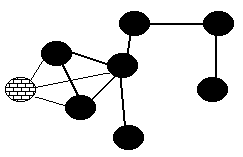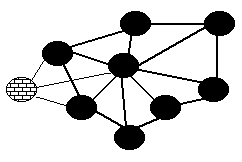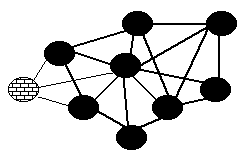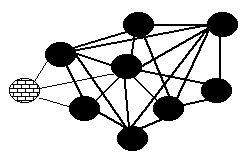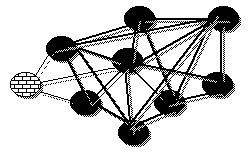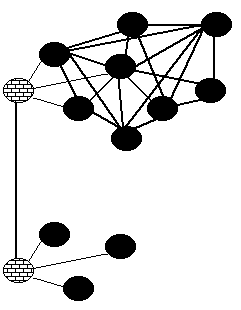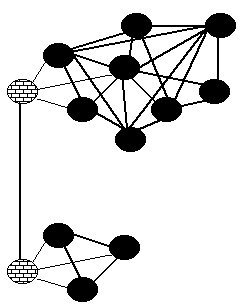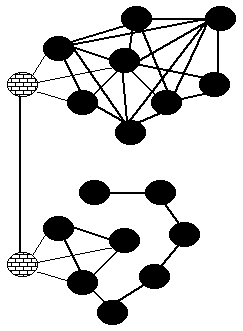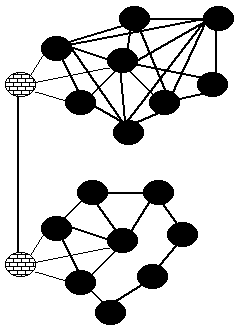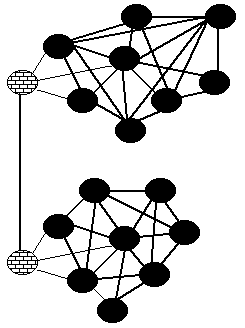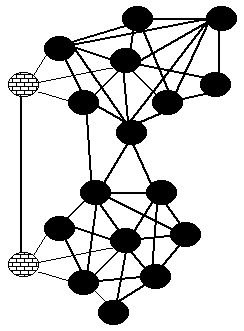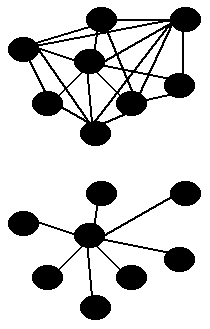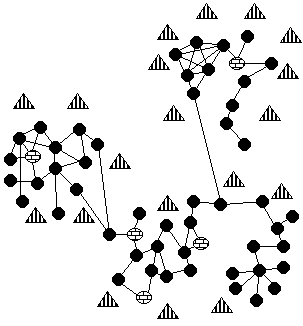|
LACEWEB SOCIOGRAMS
Figures
Depicting the Evolving of Indigenous and Small Minority Healing Networks in
East Asia Oceania Australasia Written
16 Nov 1998. Updated April 2014.
This
page uses diagrams (sociograms) to encapsulate the transfer of
micro-experiences, understandings, and healings within Laceweb networks of indigenous,
small minority and intercultural people in the Australasia, East Asia Oceania
Region. These
diagrams are all in the form of sociograms (graphic
representations of social links).
The
processes outlined are pervasively tentative. Everything depends on local
people. Nothing can happen unless local people want it to happen and
are fully involved in doing it through mutual help processes. This is why
tentative language is used. Even in giving examples it is understood that
everything is caste as possibilities. To repeat, things will happen if, and
only if locals want it. An
example from Bougainville It is noted that the PNG
Government representative back in the 1990s in opening the talks as part of
the final drafting of the UN Inter-Agency Report on Bougainville, stated that
both: 'the participation
of local people' and 'self help' processes are crucial to
any meaningful normalisation on the Island and that both should be incorporated
into the Report's recommendations. The final Report also
held out those two aspects as critical. 'Participation
of local people' and 'self help were
again reiterated in a recent statement by Bougainville Member of the PNG
Parliament, John Momis (from 2010
to currently in 2014 the President of the Autonomous Region of
Bougainville.. He noted that all sorts of Australian organisations
wanted to come into Bougainville and provide various 'services' - in effect,
to capitalise on opportunity. He cautioned
against this. The Bougainville people want to help 'themselves' to
return to normalcy. John
Momis was sworn in as
President of the Autonomous Region of Bougainville in 2010. The following view has
been expressed by many Bougainvillians: 'We Bougainville
people are very cautious of outsiders who want to come in to fix things for
us. Massive needs exist in health, education, and infrastructure to name a
few. We virtually need to start from scratch. Outside help 'is'
needed. However we do not believe that having a massive range of 'services'
devised and provided across the board by outside experts is the way.' NOTE It is noted
from a careful reading of the UN Inter-Agency Report that its own
recommendations contain virtually nothing that falls within the
PNG Government's and the Report's own guidelines requiring 'participatory
self help action by locals'. There is a dearth of 'participatory self
help models' among both Government bodies and NGO's. In the UN
Inter-Agency Report, while there was 'lip service' to 'self-help' and
'participation by locals', there was little evidence of the use of
participatory mutual-help and self-help action models. Virtually every
one of the Report's recommendation was for 'centralised' 'uniform' programs
that are 'devised', 'controlled' and 'implemented' by outsiders, and via 'top
down', 'bureaucratically organised', 'service delivery' processes. This is prescribing
forms of governance when 'governance' is a prime point of contention! It is not surprising. This
is the 'way' of the mainstream first nations. Virtually all
mainstream funding uses 'top down service delivery' models as a starting
point. This is never questioned. Both funding 'policy' and 'programs' are
based on this 'service delivery' model. It is the model used at every level
of Government. All Program funding 'criteria' and 'evaluation' are also based
on the 'service delivery' model. Any 'sense' of participation and 'self help'
is skewed into the service delivery model. There is a real dilemma
in all of this. Bougainville people have been cut off from the World for
almost a decade. 'We are traumatised. We
are very sceptical of outsiders. The last thing we want is someone coming in
and running our lives for us. And yet the only model that Governments and
NGO's have is 'service delivery'. Service delivery typically means 'You
decide and do things for us'.' 'Participatory
self-help action' as Laceweb know it, does not meet either the funding
criteria or the evaluation criteria of 'service delivery' models. These two
models belong in different worlds. To
attempt to place a top down service delivery organisation in a watchdog role
over Laceweb Action using 'service delivery' criteria to 'ensure we are doing
things 'properly' is unacceptable and unworkable in respect of Laceweb
Participatory Self-Help Action. THE ENABLING PROCESS Either
Laceweb Enablers or local indigenous, small minority or intercultural people
may identify local wellbeing nurturers. Locals seeking well-being support tend
to use these nurturers. Typically, these nurturers are 'self starters'. The
black disk symbol (Fig.01) is used to depict a local indigenous, small
minority or intercultural wellbeing nurturer.
Fig 1. It
is understood that these nurturers are always living among other locals
depicted as in Fig.1a
Fig 1a. The
cross hatched disk symbol (Fig.02) is used to depict a Laceweb enabler who
may or may not be a local. Enablers, as their name implies, enable others to
help themselves towards wellbeing. Enablers may share micro-experiences of
healing ways and peacehealing™ that other indigenous, small minority or
intercultural nurturers have found to work.
Fig 2. Typically, co-learning
takes place. That is, as a person shares healing ways with others, the sharer
also receives insights and understandings back from these recipients.
Hence, lines in the figures (as in Fig 3.) represent a two-way flow of
healing sharings.
Fig 3. The
darker line between two locals in Figure 4 represents a two-way flow
of healing sharings and also that these sharings have been adapted to
local healing ways. That is, non local enablers may share with locals
many of the micro-experiences which they have received from other places and
cultures. The local may adapt these micro-experiences to the local healing
ways. They may then pass these 'localised' healings on to other locals.
Fig.4 Figure
5 depicts an enabler sharing healing ways with three locals. In this example,
let's assume different micro-experiences are passed on to each of the
three locals.
Fig 5. Let us say the three
locals in Figure 5 each receive 3 healing ways from the enabler. They then
adapt them to local healing ways. Figure 6 depicts these three locals then
passing these micro-experiences on to each other.
Fig 6. In this example, each
local receives six healing ways via other locals - that is, three from each
of the other two locals. They each receive three healing ways directly from
the enabler. That is, they are receiving more from locals than from
the enabler. Of course, each of the ways was originally passed on by the
enabler. This process means that
locals are receiving twice as much from other locals and these sharings are
adapted to local way. Locals become the primary source for shared
ways. The enabler is in the background. The sharing of micro-experiences among locals - a
summary
Figure
7 depicts one of the three locals linking and sharing with two other locals.
Fig 7 The
sharing of healing ways may have some or all of the following features:
Figures
8, 9, and 10 depict the progressive building up of a chain of linked people
with sharings going back and forward along the chain.
Fig 8.
Fig 9.
Fig 10. In time more and more
skills are generated in the healing network and passed on to others. The role
of enabler continues to become more invisible. In figures 11 and 12 the
local who commenced the chain makes links firstly with the second and then
the fourth person in the chain. This may have the effect of enriching the
speed, flow and feedback of healing ways micro-experience. Note also that in
Figure 12 a link has also been made between one of the original three locals
and the new local not in the chain. The healing network is beginning to
expand in mutual support.
Fig 11.
Fig 12. Further
links have been made in Figure 13 so that now the local that started the chain
is directly linked to every member of the chain. The chain is also linked
into the original three via the other new member.
Fig 13. In
Figure 14 the Fourth person in the chain has linked with the first and second
person in the chain. These further links may have the potential to:
Fig 14. The
expanding network has potential for both unifying experience and enrichment
through diversity Further
linkings have been made in Figure 15. Now the 'web' like structure of the
linkings is emerging. Another term for this is ‘functional
matrix'. The word matrix is from
the Greek word having the following meanings:
In this example the
enabler has only made links with the original three locals. It may be that
further links are made between the enabler and others in the network. It is
not however necessary. Typically, the links between locals rapidly increase
ahead of the links between locals and enablers. It will be noted that by
Figure 15, the enabler may have become a relatively invisible figure. The
enabler may continue to share micro-experiences with the original locals. By
now most of the healing ways are being received from locals.
Fig 15. Healing
micro-experiences may be combined and adapted as appropriate to people, place
and context. Over 30 years of experience has demonstrated that these
processes are self enriching. People may be intuitively innovative. The local
'seed-bank' of healing stories is soon replanted and bearing fruit.
Fig 16 While the local network
depicted in the preceding series of sociograms has been emerging, the enabler
may have been linking with another enabler who is in turn linking with other
locals not known to the local network mentioned above. Figure 17 depicts such
a linking. While this second enabler also is linking with three locals, it
may be any small number. Typically, these linkings start out small.
Fig 17. Figures 18 to 23 depict
the evolving of this second network. The sequence may differ, though many of
the characteristics of the first network emerge. Linked chains of people may
emerge. Further linking strengthens the number of people available to each
other for mutual sharing and support.
Fig 18.
Fig 19.
Fig 20.
Fig 21.
Fig 22.
Fig 23. Figure
24 depicts links being made between the two local networks. As these links
are extended, the two networks may merge to be one expanded network.
Fig 24. There is always the
possibility that locals may position themselves such that they generate links
to locals without linking the locals to each other. In this way any local
doing this may become the one all the others rely on. Figure 25 shows the
original network of eight locals and underneath, another eight locals where
seven locals only have one link and that being into the local in the centre.
A moment’s reflection may give a feel for the difference between the original
network and this later form of linking.
Fig 25. This
second pattern may spread healing ways. Experience has shown that the network
with the multiple cross linkings has many advantages such as:
THE
ENABLING NETWORK Enablers
are also part of an enabling network. Figure 26 depicts the original
enabler's links to the Laceweb enabler network.
Fig 26. After a time the network
may start to link more widely into the wider community and extend through a
number of surrounding villages (settlements/towns) with links to more distant
places. The healing network starts to enable self healing among the local communities.
More and more people discover that they can change their wellbeing as
depicted in Figure 27. Nurturers begin to indentify other nurturers living in
their area with whom they have not yet established links.
Fig 27 After a time, whole
villages (settlements/towns) may enter into Cultural
Healing Action as depicted in Figure 28. The
triangular symbol represents a dwelling and the three rings of dwellings
depicts three villages located in reasonable close walking distance from each
other.
Fig 28. Note
the differing patterns of transfer depicted in Figure 28.
After
a time, locals may evolve as enablers and so further assist in the spreading
of Cultural Healing Action At
other times there may be healing celebration camp out festival gatherings of
enablers, nurturers and other locals from a number of villages (settlements/towns)
as depicted in Figure 29. These may last for days with diverse and
spontaneous cultural healing action occurring around the clock.
Fig 29. Many
changes that have occurred between Figures 28 and 29 that may have
potent implications. Refer
top of page. |






